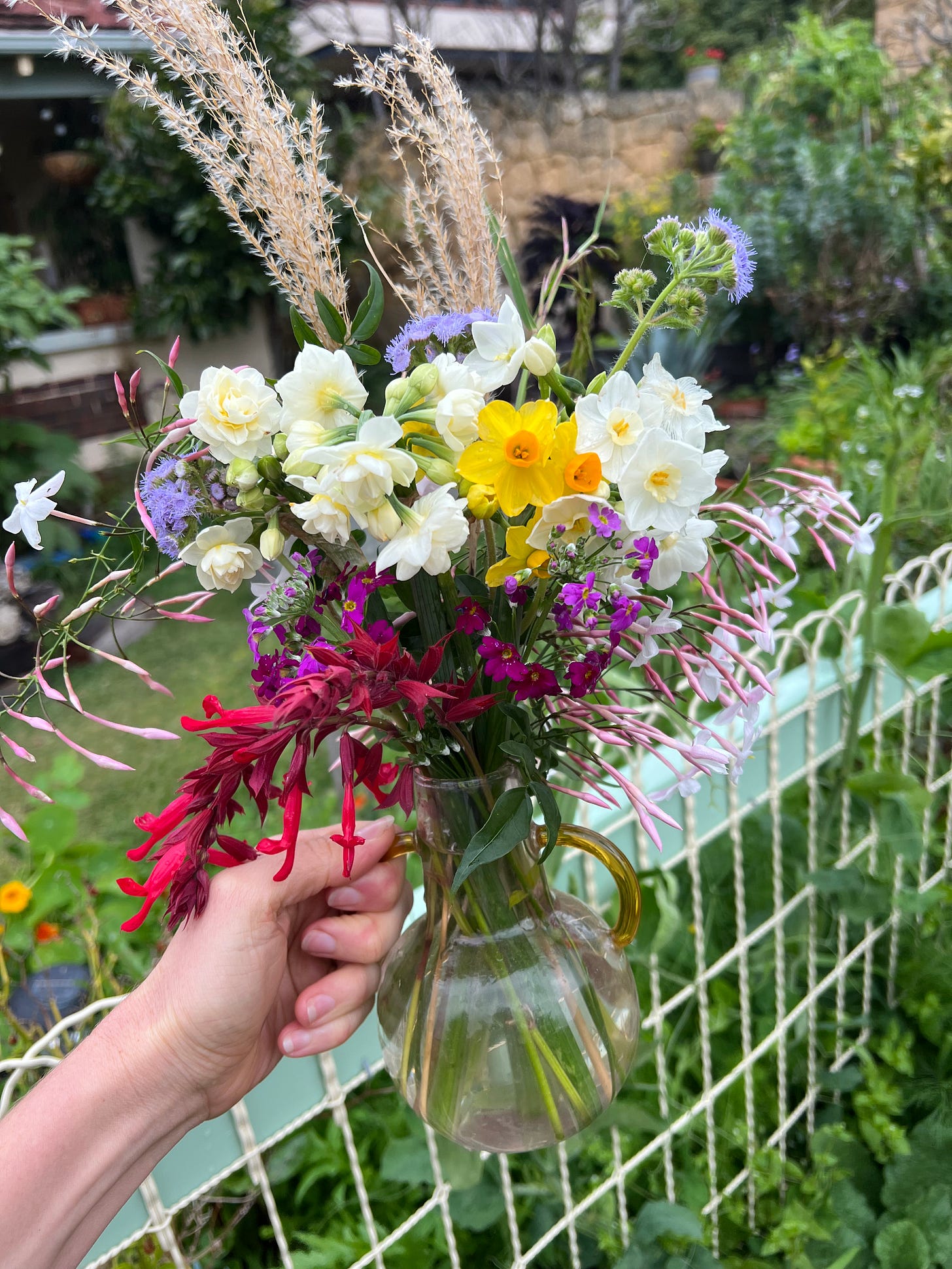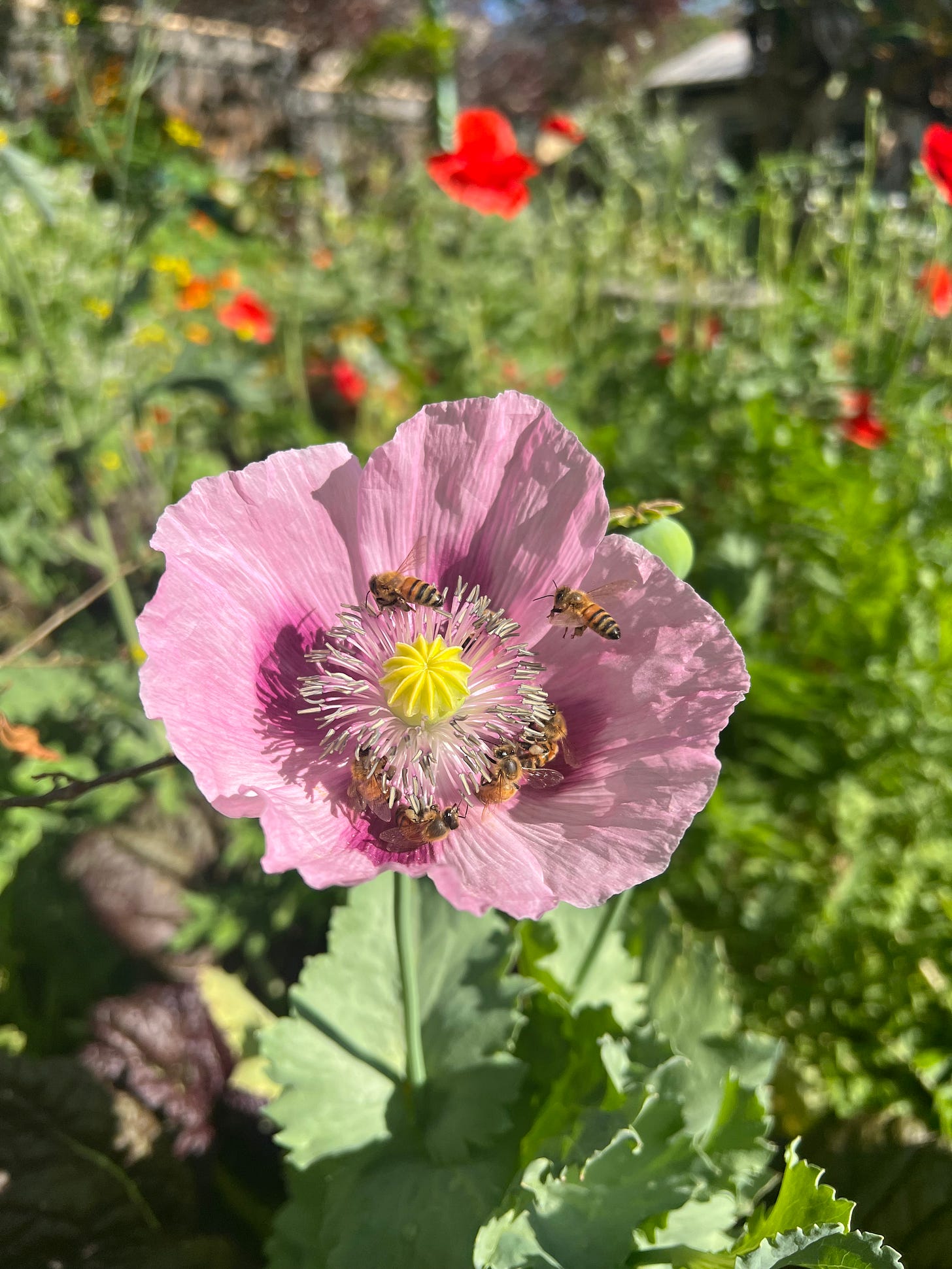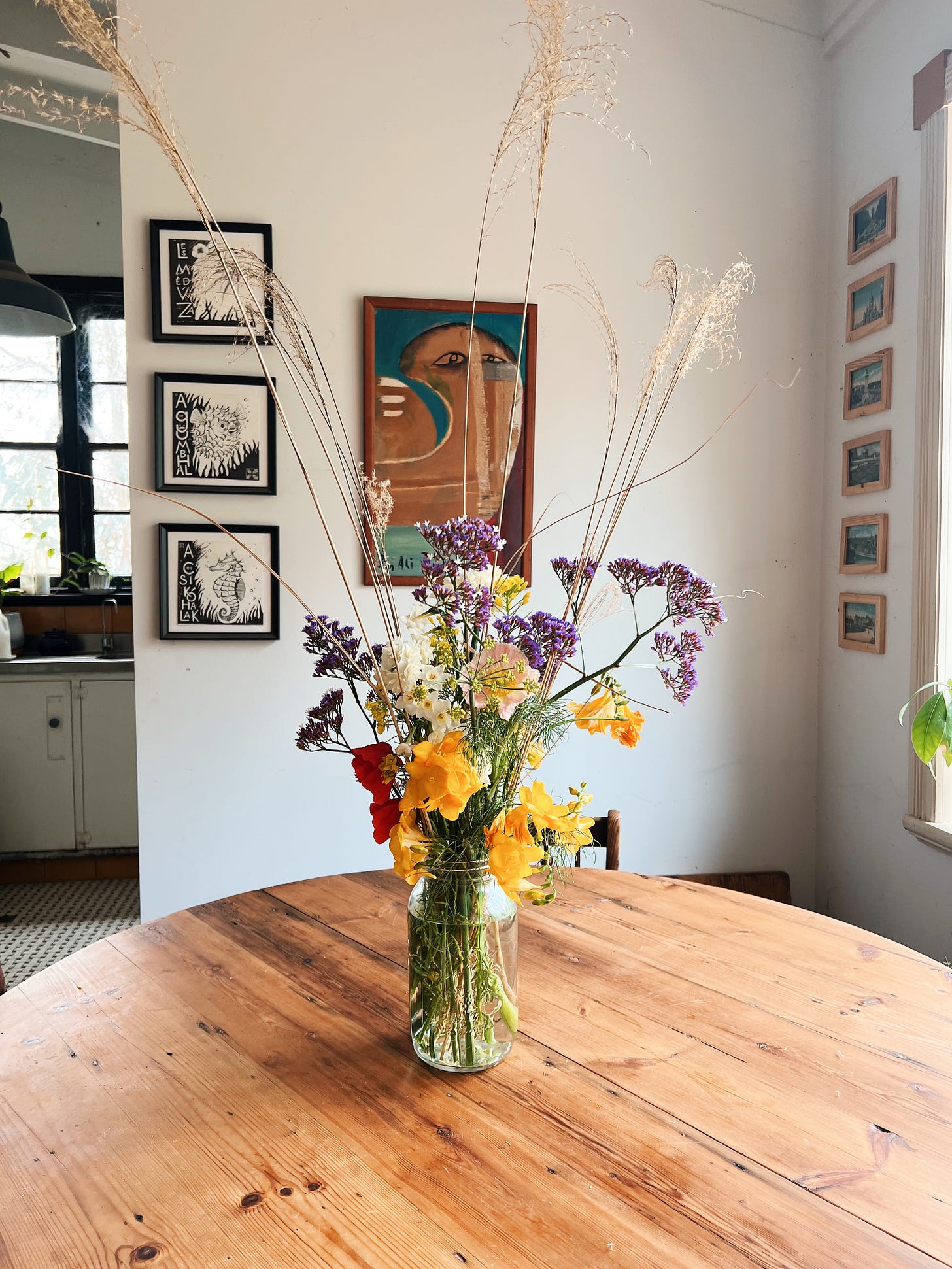A garden without flowers is...
A canvas with no paint, a song without melody, a dish without salt etc. etc.
Welcome to Lo fi life, a cheerfully unsophisticated newsletter about gardening, cooking and things that are good. Not subscribed yet? Click the button:
Notes:
Today’s newsletter is free to all subscribers (I hope you enjoy it!)
On Thursday, I’ll be sending out an extra email for paid subscribers only. It’s a recipe for the BANGIN’ bitter orange marmalade & lemon shortbread I made over the weekend. It’s salty, it’s sweet, it’s bitter - it’s delightful. I’ve been experimenting with the best way to make marmalade with fresh oranges all winter and I think I’ve finally nailed it!
If you’d like to receive my Thursday emails, please consider becoming a paying member of Lo fi Life. You’ll be helping me devote more time to bringing you delicious recipes and the best gardening advice I can! :)
Wanna keep reading for free? That’s fine too! Please do me a solid and share this newsletter with a friend. I’d love to be able to get my newsletter in front of more people - your help with that would really mean a lot :) - click the button below to share.
Flowers are one of life’s greatest joys. But, sadly, they are also often overlooked when people decide to start a veggie patch.
Yes, growing your own fruits, veggies and herbs is wonderful, but I’ve noticed many people will tend to make their veggie patches kind of utilitarian spaces, at least in the beginning. The focus is often on productivity, on neat lines of veggies, giant harvests and aspirational veggie hauls. In these gardens, frilly, inedible, superficial things like flowers can seem like totally pointless additions. And don’t get me wrong, I like a garden full of prolifically fruiting veggies as much as the next person, but a singular focus on growing ‘productive’ plants can often mean gardeners neglect to grow the one thing that will drastically increase both the health and the productivity of their patch: Flowers!
Why grow flowers
It’s not just that they’re fragrant, fun and beautiful to look at, flowers are key players in any veggie patch. You might not be able to eat them (although there are actually plenty of wonderful edible flowers) but they are contributing to your garden in numerous, hugely valuable ways.
They provide pollen
Which helps attract bees, wasps, ladybirds, lacewings, hoverflies and other beneficial insects.
Many also provide nectar
Which can help to attract butterflies and birds. For nectar-rich blooms, plant salvias, zinnias, lavender, cosmos, marigolds, yarrow and buddleias.
They add colour, fragrance and interest to your garden.
Veggie gardens are often a little devoid of colour; flowers help make the space more beautiful.
They tend to be less palatable to bugs than veggies.
You’re much more likely to have your brassicas nibbled by caterpillars than your marigolds. For whatever reasons, a lot of the veggies we grow (particularly salad greens and members of the brassica family) are appealing targets for a wide range of garden bugs. Flowers tend to be devoured a lot less often, and because of this, can act as handy decoys to confuse the bug who frequent your patch. If your tasty patch of lettuces is surrounded by unpalatable marigolds, the marigolds can act as a deterrent, helping keep the bugs away.
They help improve your veggie yield.
Because they bring more bees into your garden, they increase the chances that your veggie flowers will be pollinated. More successful pollination = more fruit for you toenjoy! This is especially true for veggies that have separate male and female flowers (like zucchinis, cucumbers and other melons). For successful pollination to occur, a bee has to travel from the male flower to the female flower, depositing pollen as it goes. The more bees you have, the more likely this is to occur, leading to a bigger harvest.
They provide a natural form of ‘pest’ control.
Because they attract such a wide and diverse range of insects, flowering plants can help you grow a garden that has a healthy balance of different insect populations. This means you’ll have more predatory bugs in your garden to help control the numbers of other so-called ‘pests’. For instance, ladybird larvae will eat aphids, as will hoverfly larvae. Parasitic wasps lay eggs inside aphids and caterpillars, killing them from the inside out (it’s grizzly but cool!), and birds that come to your garden to feed off the nectar in your flowers might also help you out by nibbling a slater or grasshopper at the same time. Rather than bothering to spray your garden with pesticides (a poor, short term solution), aim to fill it with flowers that encourage a broad range of insects to call your garden home. You will find your ‘pest’ problems resolve themselves much more easily, and your garden will look more beautiful too!
Tips for successful flower growing
Flowers need the same things all plants need to thrive: the right amount of sunlight, water and healthy soil. Although happily I find them to be a little less fussy than veggies. Because veggies grow so big so quickly, they often need a lot of nutrients and water to really thrive. This is especially true for veggies that produce really giant fruits like zucchinis and watermelons. Flowers tend to be a little less needy, but they will still do a lot better if you grow them in soil that has been enriched with manure and organic matter, mulched with lupin mulch or pea straw and well watered.
Pay attention to sunlight.
Like most veggies, flowers need a fair bit of sunlight to perform well. As a rule of thumb, aim for at least 6-8 hours of direct sunlight each day for most flowering plants. There are of course flowering plants that don’t need - or want -nearly that much sunlight (e.g., Peruvian lilies, Shasta daisies, pelargoniums, oyster plants and begonias), but for many, many flowering plants, the more sunlight you can give them, the more blooms they will provide you with. When flowering plants that like full sun conditions are grown in shadier spaces they will tend toflower less prolifically and may be more susceptible to bugs and diseases.
Boost your soil regularly.
As with your veggies, healthy, rich soil will lead to healthy flowering plants. So make sure to regularly amend your soil with manure and compost, topped with a good quality mulch (for more information on soil improvement don’t forget to check back to our soil improvement guide from Week 2).
Remember to deadhead spent blooms.
If you want to extend your flowering window and enjoy more blooms from each plant, don’t forget to deadhead your flowers! When finished blooms are left on the plant, it sends a signal to the plant that it’s time to switch gears from producing flowers to setting seed. You’ll notice the plant starts to produce fewer flowers, and the spent flowers that remain on the plant turn quickly into seed pods or seed heads. You can slow this process down and encourage the plant to produce more blooms by simply removing the spent blooms once they finish. For a lot of flowering plants, removing the spent blooms (deadheading) encourages fresh waves of blooms, meaning the more flowers you pick, the more flowers you’ll get to enjoy. This is particularly true of sweet peas, so if you decide to grow sweet peas in your patch for spring, make sure to pick their flowers regularly, only leaving them toform seed pods once summer has started to set in.
Choose flowers that are pollen rich.
Not all flowers are created equal, and some contain a lot more readily-accessible pollen than others. These are the ones you want in your garden, as they will attract the bees and other beneficial insects. Some of the best, most pollen-heavy flowers you can grow include: daisies, borage, salvias, comfrey, poppies, perennial basil, passionfruit marigold, echium, cornflowers, sweet alyssum, buddleias, milkweed, hollyhocks, queen anne’s lace, lavender, sunflowers, marigolds, calendula, nasturtiums, yarrow, zinnias and asters.
Some herbs and vegetables also produce glorious flowers that are fantastic for bees. They trick is to leave them in the ground after you’ve finished harvesting their fruits or leaves, giving them an opportunity to burst into bloom before you pull them out. Some of the best herbs and veggies to let flower in your garden include: coriander, basil, broccoli, mustard greens, fennel, sage, rosemary, thyme, parsley, mint, chives, leeks, onions, carrots, radishes, beetroot and chicory.
Avoid growing flowers that don’t provide pollen.
On the flip side, it’s a good idea to avoid growing flowers that don’t provide much pollen (like petunias and vincas). If you like them, by all means, chuck ‘em in, but make sure you’re also growing a lot of pollen heavy flowers too.
Collect and save seeds.
And don’t forget to collect and save the seeds from your flowering plants. One of the wonderful things about growing flowers in your garden is that a lot of them have seeds that are so easy to save and sow again next year. Some of my favourites include sweet peas, marigolds, calendula, hollyhocks, nasturtiums and poppies. Seeds from these flowering plants can all be readily harvested once the seedheads are dry. Pop them in a paper envelope and store them somewhere cool and dry until the time comes to re-sow them.
Pick them!
And, if you already have flowers blooming in your patch, here’s one extra job for you: go out and pick some! I often neglect to pick my flowers. I’ll enjoy them in the garden every morning, but somehow the habit of actually picking a few to take inside to admire tends to fall by the wayside. Every time I actually do pick a bunch I’m reminded just how wonderful they are. So, if you’re anything like me, here’s your reminder to pick yourself a posy - it’s guaranteed to make you smile.









Thank you for this beautiful, gentle reminder to include more blooms this growing season Casey!